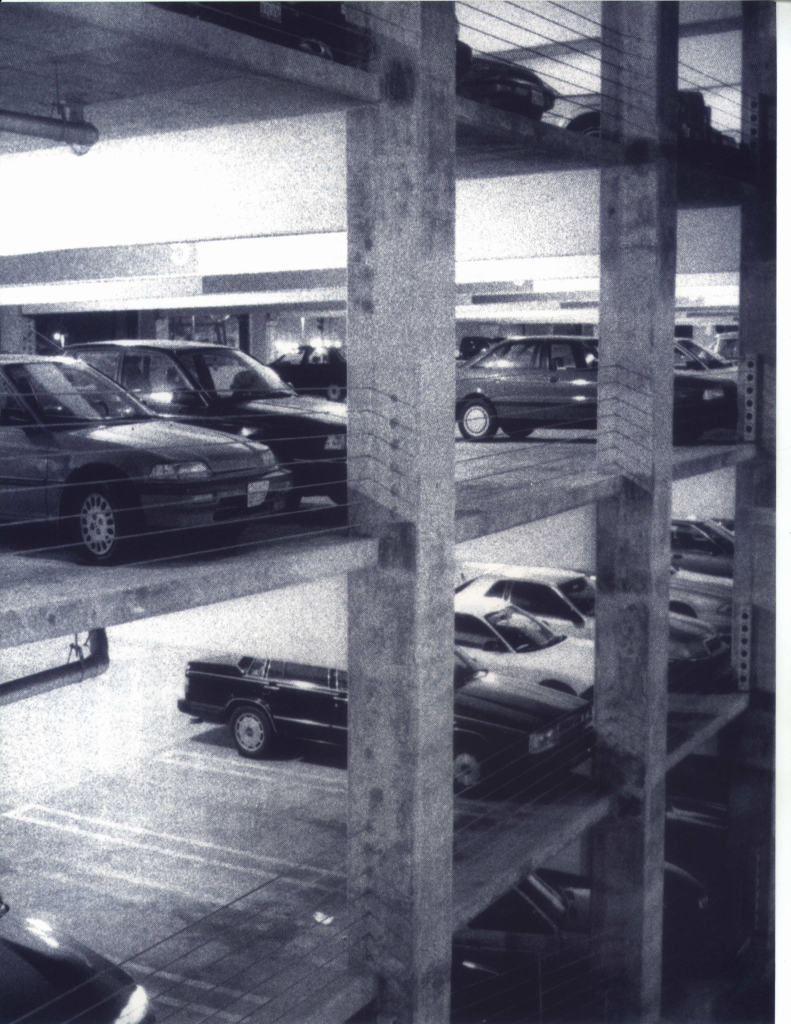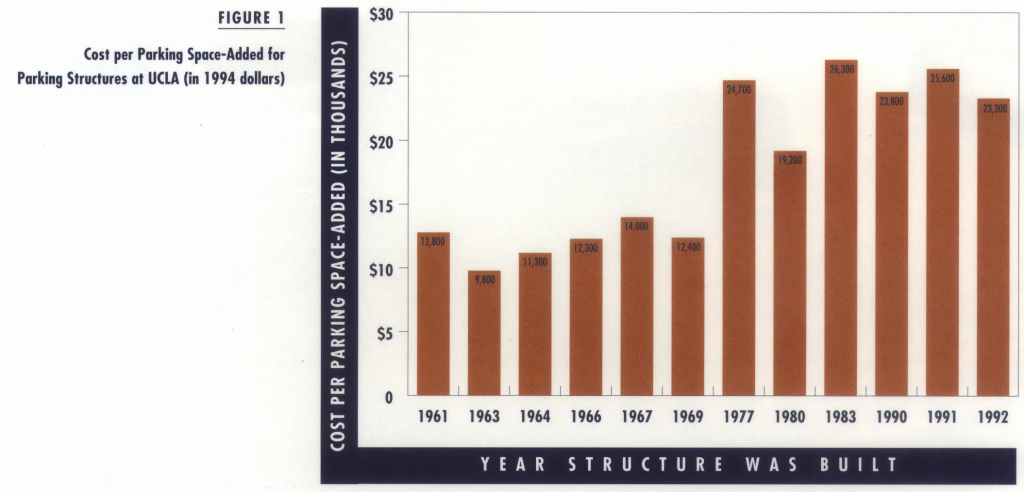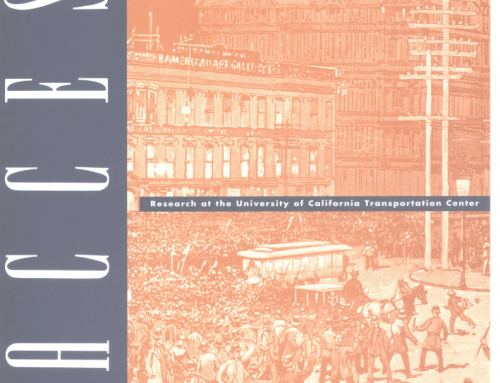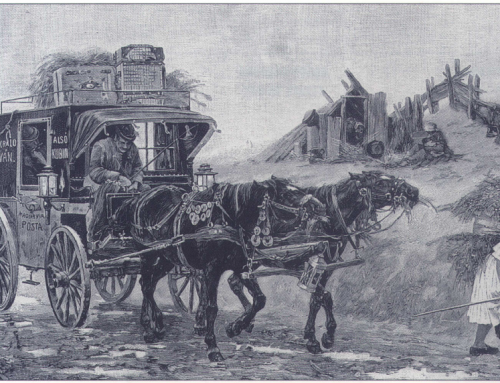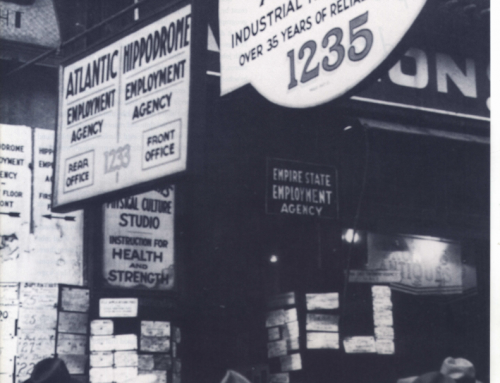Ask anyone to define a livable city. Some will say clean air and safe streets. Others will mention good restaurants, affordable housing, pleasant parks, or less traffic congestion. But, chances are, they’ll all agree on one thing – plenty of free parking.
Almost everywhere, people expect free parking. Urban planners have responded by requiring off-street parking for all new construction. According to the Planning Advisory Service, parking requirements are a major concern among city planners, generating more inquiries each year than any other topic. Parking requirements are a critical link between transportation and land use. To understand this link, I have tried to calculate the cost of minimum parking requirements. The findings suggest that minimum parking requirements seriously distort the markets for both transportation and land. The findings also suggest an alternative policy for improving parking, transportation, and land use.
How Do Planners Set Minimum Parking Requirements?
Practicing planners use simple empirical methods when setting minimum parking requirements. They count the cars parked at existing land uses and identify “peak demand” as the minimum number of parking spaces “needed.”
The only source of data that systematically relates parking demand to land use is Parking Generation, published by the Institute of Transportation Engineers. This report calculates the “parking generation rate” – the average peak parking demand observed in case studies – for sixty-four different categories of land use.
Although the case studies do not refer to the price of parking, most parking must be free, because the 1990 Nationwide Personal Transportation Survey found that parking is free for 99 percent of all automobile trips in the United States. Planning for parking is therefore planning without prices.
Parking generation rates are therefore based on observing peak demand for free parking. By using these parking generation rates to set minimum parking requirements, planners short-circuit the price system in both transportation and land markets, ultimately creating many unintended, but not unforeseeable, consequences.
How Much Does A Parking Space Cost?
To introduce cost considerations into planning for parking, we can start by asking how much a parking space costs. There is no simple answer to this question, but for a parking structure, we can consider both the cost of building the structure and the number of parking spaces it adds. Note that parking structures add fewer new spaces than they contain because the land occupied by a structure could be used for surface parking if the structure were not built.
For example, consider a 750-space parking structure built on the UCIA campus in 1980. The structure was built on a surface lot that had provided 200 spaces. Although the structure contains 750 spaces, it added only 550 spaces to the parking supply. The construction cost was $10.5 million (in 1994 dollars). Therefore, each space added to the parking supply costs $19,000 ($10,500,000/550 spaces).
Calculating the construction cost per space-added by a parking structure implicitly accounts for land cost by assuming the structure’s site could otherwise be used for surface parking. Using this method, I have estimated the cost of parking spaces added by twelve parking structures built on the UCLA campus between 1961 and 1991.
Figure 1 shows the cost (in 1994 dollars) per space-added by each parking structure, and it reveals a striking pattern. The average cost of structures built in the 1960s was $12,400 per space-added, while the average cost of structures built since 1977 was $23,600 per space-added. After correcting for inflation, the spaces added since 1977 cost almost twice as much as the spaces added in the 1960s.
The newer structures tend to be more expensive for two reasons. First, five of the six structures built since 1977 are wholly or partially underground, and thus required expensive excavation, fireproofing, and ventilation equipment. Second, the newer structures are smaller. Post-1977 structures have an average of 43 percent fewer spaces, making each space more expensive because the costs for ramps, elevators, and stairwells are fixed.
The high value of land does not directly explain the high cost of parking spaces added since 1977. The high value of land indirectly explains the high cost of recent parking spaces, however, because in recent years the scarcity of vacant land has prompted underground or small structures, which require more expensive methods of construction.
Parking Requirements Raise Housing Costs and Reduce Density
Suppose a developer must pay $23,600 per space to provide the parking required by a city. How would this affect the cost of real estate development, and should it affect the planning decision about how many parking spaces to require?
The only available research on the topic suggests that parking requirements raise housing costs, reduce urban density, and reduce land values. In 1961, the city of Oakland, California, began requiring one parking space per dwelling unit for apartment buildings. Figure 2 shows that after parking was required, the construction cost per dwelling unit rose by 18 percent, housing density fell by 30 percent, and land values fell by 33 percent.
Why did the parking requirement cause developers to build fewer but more expensive apartments? Because every additional apartment required an additional parking space, but larger apartments did not require more parking spaces than smaller ones.
Oakland’s requirement provided more parking, but it also increased the cost of housing and reduced density. The cost of parking a car was incorporated into the cost of renting an apartment, making cars more affordable and housing less affordable. Housing investment per acre fell by 18 percent after the parking requirement was imposed.
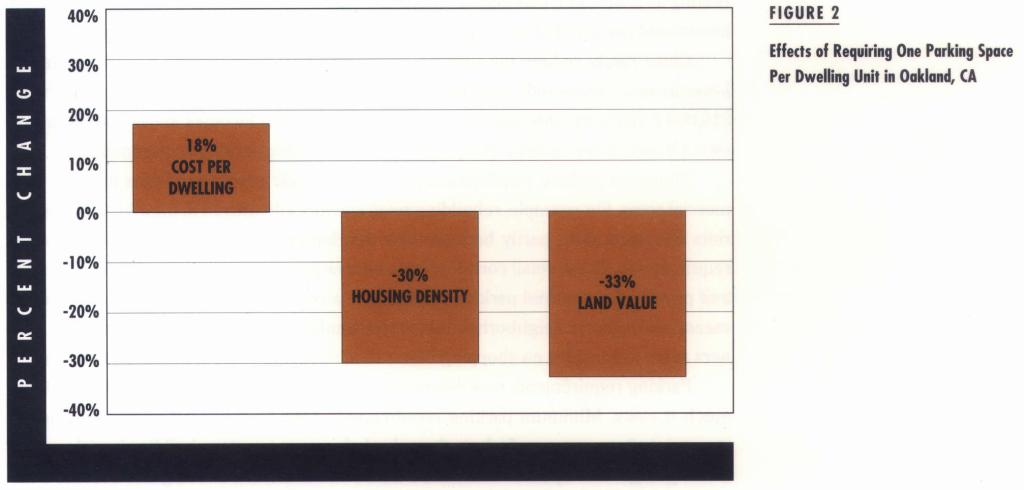
Cities rarely reduce the parking requirements for low-income housing, although lower-income households own fewer cars. On average, households with incomes below $10,000 a year own only one car, while households with incomes above $40,000 a year own 2.3 cars. Nevertheless, everyone pays for minimum parking requirements.
Minimum parking requirements create especially severe problems in older commercial areas. For example, rebuilding retail corridors destroyed in the 1992 Los Angeles riots has been slow, partly because new developments must meet the city’s parking requirements. These retail corridors have narrow parcels, so it is difficult to build a store and provide the required parking on them. As a result, much commercial land remains vacant, and adjacent neighborhoods lack retail outlets, even grocery stores. In effect, planners seem to consider no shopping better than shopping without ample free parking.
Parking requirements now determine what can be built, what it looks like, and how much it costs. Minimum parking requirements have transformed many Los Angeles streets into “garagescapes” where the only obvious way to enter a building is with an electronic garage-door opener. California’s traditional courtyard housing has become a historic style that cannot be replicated with today’s parking requirements. Form no longer follows function or fashion, or even finance. Instead, form follows parking requirements.
Demand for Minimum Parking Requirements
Minimum parking requirements act like a fertility drug for cars. Why do urban planners prescribe this drug? One explanation is that planners are not exercising professional judgment. They are simply responding to political pressure. People want cars, and they need to park them somewhere.
Minimum parking requirements are a remarkably popular land use regulation. In 1946, a survey of 76 cities found that only 17 percent had off-street parking requirements in their zoning ordinances. Five years later, 70 percent of these same cities had off-street parking requirements or  were in the process of adopting them. Has any other land use regulation ever spread so quickly? ·
were in the process of adopting them. Has any other land use regulation ever spread so quickly? ·
Planners require developers to increase the parking supply by as much as they increase parking demand. The problem lies in estimating parking demand. Planners simplify the problem by assuming that parking is free.
Because planners base minimum parking requirements on the peak demand for free parking, there is usually a surplus of parking spaces. That helps to explain why the 1990 Nationwide Personal Transportation survey found that motorists park free for 99 percent of all automobile trips in the United States. Minimum parking requirements provide for subsidies that inflate parking demand, and this inflated demand is then used to set the minimum parking requirements.
Minimum parking requirements have severed the link between the cost of providing parking and the price that people pay for it. The cost of providing parking has therefore ceased to influence most decisions about whether to own or use a car. Because people pay nothing for parking, they own and use cars as if parking costs nothing, thus contributing to traffic congestion. When citizens object to congestion, planners restrict new development to reduce traffic. That is, minimum parking requirements force new development to subsidize cars, and planners must limit the density of development (and of people) to limit traffic. In many places free parking has become the arbiter of urban form, and cars have replaced people and buildings as zoning’s real density concern.
Because market prices can easily allocate parking spaces, urban planners have no analytic basis for requiring parking in any fixed proportion to land use. The hapless urban planner who must foretell the parking “needs” for every land use is cast as the Wizard of Oz. At the end of L. Frank Baum’s story, Dorothy’s little dog, Toto, knocks over the screen hiding the Wizard, who confesses, “I have fooled everyone so long that I thought I should never be found out. .. [but] how can I help being a humbug when all these people make me do things that everybody knows can’t be done?”
An Alternative to Minimum Parking Requirements
Urban planners require land developers to supply enough off-street spaces to satisfy the peak demand for free parking, so that new buildings will not cause parking shortages. But the developer’s failure to supply ample off-street parking does not cause shortages. Rather, government’s failure to charge market prices for scarce curb parking causes the shortages.
If the government set curb-parking prices high enough to assure that there are always vacant spaces (the way commercial operators price off-street parking), any increase in demand for the fixed supply of curb spaces would increase their price, and shortages would not occur. The government could eliminate minimum parking requirements, and receive the market value of spillover parking as public revenue.
To make this pricing solution politically viable, I have proposed creating “Parking Benefit Districts,” which are like existing Residential Permit Parking (RPP) districts except that nonresidents would pay to park at the curb. Curb-parking revenue would be used to finance public services for residents in the neighborhood where it is collected. For example, curb-parking revenues can be used to repair sidewalks, plant street trees, or to put the overhead utility wires underground. Even at modest prices for nonresidents’ parking, curb-parking revenue could easily exceed the existing property tax revenue in many neighborhoods.
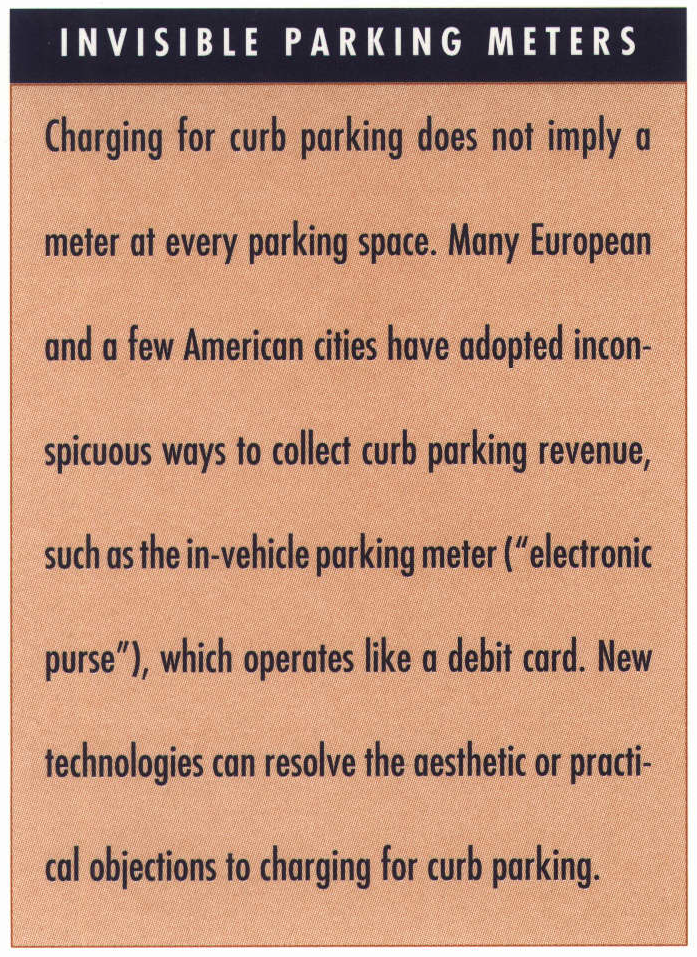 At the simplest level, cities might try Parking Benefit Districts by selling to nonresidents a few daytime permits to park in existing RPP districts. Neighborhoods near commercial developments often establish RPP districts so commuters’ cars won’t congest their curb parking. An RPP district is a minor but real inconvenience for the residents, who must buy permits for their own cars, and deal with restrictions for their guests’ cars. RPP districts create a high vacancy rate for curb parking in residential neighborhoods, while nearby commercial developers must build expensive parking structures for commuters. In this situation, a city might sell two or three daytime RPP permits per residential block to commuters, and use the resulting revenue to eliminate charges for the residents’ own permits.
At the simplest level, cities might try Parking Benefit Districts by selling to nonresidents a few daytime permits to park in existing RPP districts. Neighborhoods near commercial developments often establish RPP districts so commuters’ cars won’t congest their curb parking. An RPP district is a minor but real inconvenience for the residents, who must buy permits for their own cars, and deal with restrictions for their guests’ cars. RPP districts create a high vacancy rate for curb parking in residential neighborhoods, while nearby commercial developers must build expensive parking structures for commuters. In this situation, a city might sell two or three daytime RPP permits per residential block to commuters, and use the resulting revenue to eliminate charges for the residents’ own permits.
Selling daytime RPP permits to nonresidents can generate substantial revenue. For example, Los Angeles charges residents $15 a year per car for permits in RPP districts. One nonresident permit at a price of $100 a month ($1,200 a year) will replace the residents’ payments for eighty cars. One nonresident permit will more than replace the median property tax on a single-family house ($922 a year) in the United States.
Parking Benefit Districts can create a symbiotic relationship between parking generators and their nearby neighborhoods, because spillover parkers will be paying guests. Market prices allocate cars and gasoline, and market prices can allocate parking spaces just as easily. Because parking prices can be set to yield any desired vacancy rate for curb spaces, pricing can eliminate parking shortages.
Eliminating parking requirements will encourage adaptive reuse of older buildings that lack parking, and encourage infill development on sites where providing off-street parking is difficult. Emancipated from minimum parking requirements, land and capital will shift from parking to land uses that employ more workers and pay more taxes. The option to build without providing parking will encourage land uses that rely on pedestrian and transit access, and that offer shopping opportunities to nearby neighborhoods. Finally, residents who (collectively) own and profit from their curb parking will welcome nearby development that has little off-street parking, because it will increase the demand for the curb parking they sell to nonresidents.
The full benefits of eliminating parking requirements will not occur overnight. The long-range benefits will occur only after the supply and demand for parking have adjusted to user-paid prices that cover the full cost of providing parking spaces. But significant benefits can occur quickly if eliminating parking requirements encourages infill development on small sites that are now vacant or are used only as surface parking lots.
Conclusion
Minimum parking requirements raise the cost of development and provide large subsidies to cars. They are a hidden tax on development to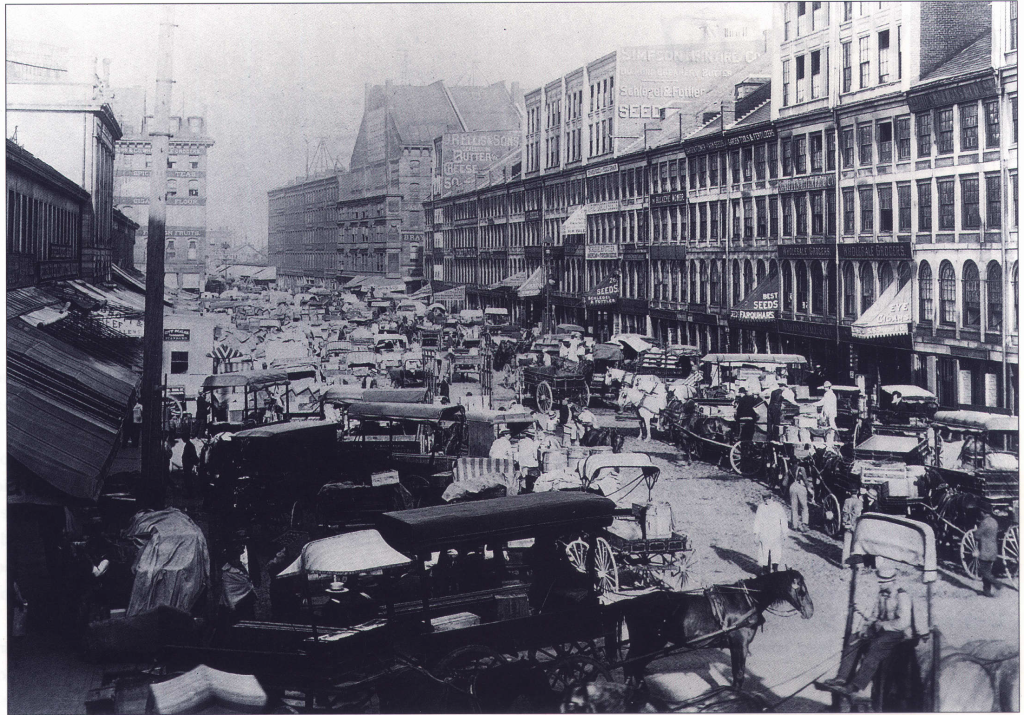 subsidize parking. If planners want to encourage housing development and reduce traffic congestion, why tax housing to subsidize parking?
subsidize parking. If planners want to encourage housing development and reduce traffic congestion, why tax housing to subsidize parking?
Eliminating minimum parking requirements does not imply ceasing to plan for parking. Rather than regulating the number of spaces, urban planners can focus on better regulating the many other dimensions of parking – curb cuts, landscaping, layout, location, pedestrian access, provisions for the handicapped, setback, signage, stormwater runoff, and visual impact. Planners can focus on the quality of parking, not the quantity. Properly pricing curb parking and eliminating minimum parking requirements will improve transportation, land use, and urban life.
Further Readings
Institute of Transportation Engineers, Parking Generation, Second Edition (Washington, DC: Institute of Transportation Engineers, 1984.
Shoup, Donald, “An Opportunity to Reduce Minimum Parking Requirements,” Journal of the American Planning Association, Vol. 61, No. 1, 1995, pp. 14-28, UCTC No. 204.
Weant, Robert and Herbert Levinson, Parking (Westport, Connecticut: Eno Foundation, 1990).
Willson, Richard, “Suburban Parking Requirements: A Tacit Policy For Automobile Use and Sprawl,” Journal of the American Planning Association, Vol. 61, No. 1, 1995, pp. 29-42.

